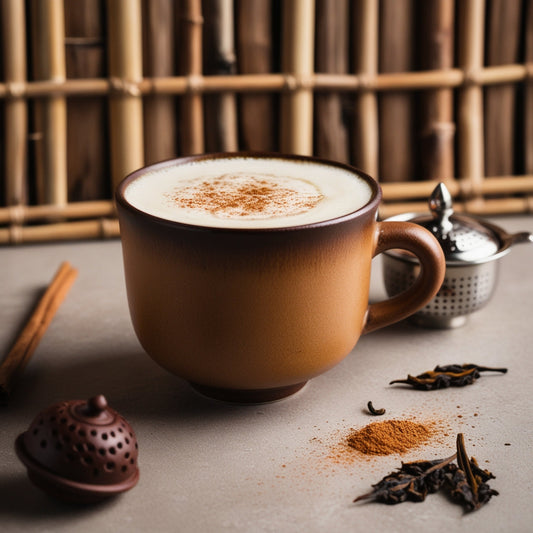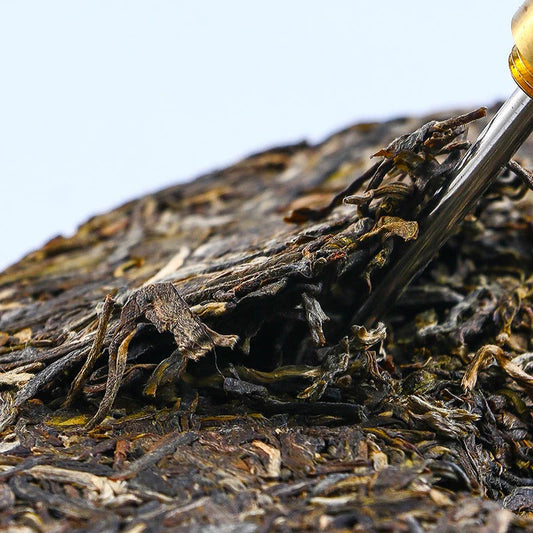Introduction
Have you ever wondered if a tea could not only delight your taste buds but also transform your health? Pu-erh tea, a unique fermented tea from China's Yunnan province, might be your perfect match. Celebrated for centuries, Pu-erh tea offers a rich history, diverse flavors, and numerous health benefits. From aiding digestion and weight management to supporting cardiovascular health. Lets explore the fascinating world of Pu-erh tea, uncovering its origins, health benefits, and the best ways to brew and enjoy this exceptional beverage with this beginners guide .
Table of Content
- Introduction
- What is Pu-erh Tea
- Taste Profile of Pu-erh Tea
- Brewing process
- Health Benefits
- Storing tips
- Conclusion
What is Pu-erh Tea
Pu-erh tea, a distinctive and flavorful beverage, originates from the Yunnan province in China. For centuries, the people of this region have cultivated and perfected the art of producing Pu-erh tea. Unlike other teas, Pu-erh undergoes a unique fermentation process that enhances its flavor and health benefits. This ancient practice, passed down through generations and has made Pu-erh tea a treasured part of Chinese culture and tradition. Today, tea enthusiasts worldwide enjoy Pu-erh tea not only for its rich taste but also for its numerous health advantages, making it a timeless and valuable addition to any tea lover's collection.
According to Traditional Chinese Medicine, Pu-erh tea has a warming and potent digestive property. Chinese doctors consider Pu-erh as a tea that dispels or cleanses the body of fat and toxins from meat and oily foods. This is also why Pu-erh has such a wide appeal amongst many Asian food cultures. Tests conducted in China report that Pu-erh can lower the alcohol level in the bloodstream.
The journey of Pu-erh tea begins with the careful selection and harvesting of the tea leaves. After harvesting, the tea leaves undergo withering, a process that reduces their moisture content. Once the leaves have withered, they are pan-fried to halt the oxidation process. Fermentation of Pu-erh is the defining step in the production of Pu-erh tea. The leaves are piled and left to ferment naturally.
Taste Profile of Pu-erh tea
Pu-erh can have a variety of flavours, including sweet, bitter, floral, mellow, woody, astringent, sour, earthy, watery, or even tasteless. Multiple flavours can be present in a single steeping and keep in mind that the taste also evolves as the tea ages. Raw Pu-erh (sheng cha) and Ripe Pu-erh (shu cha) are the two main categories of pu-erh.

Taste of Raw Pu-erh Tea (Sheng cha)
Raw Pu-erh possesses an array of aromas and flavours. It typically has a stronger green vegetal flavour and is generally bitter. However, after several years of natural aging, the bitterness fades, giving way to a delightful aged aroma.
Taste of Ripe Pu-erh Tea (Shu cha)
Ripe Pu-erh has undergone full fermentation, much of the bitterness and astringency inherent in the tea leaves have dissipated. Ripe Pu-erh is generally earthy, nutty or woody. Good quality aged Pu-erh should be mellow, smooth and offer a sweet aftertaste.
Brewing process
Brewing Pu-erh tea pressed into cake form requires vital steps. Producers conventionally compress Pu-erh tea into a solid, flat shape for easy delivery and storage. To start your journey in brewing your first Pu-erh tea, you must first break the Pu-erh tea cake apart into pieces that can fit efficiently in your bowl or teapot. There are two methods to brew pu-erh tea Traditional Chinese Method and Modern method.
Traditional Chinese Method
This method of brewing Pu-erh tea is complex but rewards the tea drinker with a cultural experience and a deeper understanding of Chinese tea practices.
- Rinse and warm the tea set using hot water. Pour the hot water into the tea pitcher, pot, and tea cups. Swirl and discard the water.
- Place tea leaves in the teapot and pour a small amount of hot water on top, using just enough to cover the leaves. Swirl for 2 to 3 seconds and discard the water, but do not discard the wet tea leaves.
- If you are brewing ripe Pu-erh tea, repeat the rinse of the tea leaves once more. For raw Pu-erh tea, only rinse once and then proceed to the next step.
- Fill the teapot with hot water at 195 degrees Fahrenheit or 91 degrees Celsius.
- Cover the pot with the lid and pour a small amount of hot water on the lid.
- After 10 to 20 seconds, the water on the lid should be dry. Once the lid is dry, pour out the tea into the tea cups and enjoy!
Modern Method
This brewing method is perfect for individuals new to Pu-erh tea or those seeking the simplest way to brew a cup.
- Use a tea scoop to measure the right amount of loose leaf tea. If using a Pu-erh tea cake, use a small pick or spoon to remove 3 to 4 grams of the compressed tea for every 8 ounces of water.
- Place the Pu-erh tea in a tea infuser. You can use a tea kettle with a built-in infuser, or a tea basket or pincer infuser with a normal kettle.
- Rinse the Pu-erh leaves with a small amount of hot water. Swirl the hot water around the leaves and then discard the water.
- Heat the water in a tea kettle or on the stove until it reaches 195 degrees Fahrenheit or 91 degrees Celsius. Pour the hot water into a tea cup and place the tea infuser with Pu-erh leaves in the cup. Avoid using boiling water as it can create bitter flavours.
- Steep the Pu-erh tea for 2 to 4 minutes. Start tasting after two minutes and then every 30 seconds until you find your preferred flavour.

Health Benefits
Weight Management
One of the most celebrated benefits of Pu-erh tea is its potential to aid in weight management. Studies have shown that Pu-erh tea can help reduce body fat and lower cholesterol levels. The fermentation process produces compounds that can enhance fat metabolism.
Digestive Health
Pu-erh tea is renowned for its ability to improve digestive health. The fermentation process increases the production of beneficial probiotics, which can help balance the gut micro bacteria.
Cardiovascular Health
Regular consumption of Pu-erh tea has been linked to improved cardiovascular health. The tea contains antioxidants such as catechins and flavonoids, which can reduce oxidative stress and inflammation.
Blood Sugar Regulation
Pu-erh tea can also play a role in regulating blood sugar levels. Some studies suggest that the compounds in Pu-erh tea can enhance insulin sensitivity and reduce blood glucose levels.
Anti-Cancer Properties
Emerging research indicates that Pu-erh tea may have anti-cancer properties. The tea's high antioxidant content can help protect cells from damage caused by free radicals, potentially reducing the risk of cancer.
Storing tips
To preserve Pu-erh tea, store it in a cool, dry place away from direct sunlight. Use breathable containers like clay jars, bamboo wrappers, or paper boxes to allow airflow. Maintain a stable temperature and avoid rapid changes to protect the tea's integrity. Ensure moderate humidity, around 60-70%, to prevent mould while keeping the tea from becoming too dry. Proper storage will enhance the aging process and improve the tea's flavour over time.
Conclusion
Pu-erh tea is more than just a flavorful beverage; it’s a treasure trove of health benefits. From aiding digestion and weight management to supporting cardiovascular health and regulating blood sugar levels, this unique tea from China’s Yunnan province can significantly enhance your well-being. With its rich history, diverse flavors, and numerous health advantages, Pu-erh tea deserves a place in every tea lover's collection.
Start your journey with Pu-erh tea today. Explore its robust flavors, experience its health benefits, and embrace a healthier lifestyle. Visit Puerh Craft to find the finest selections of Pu-erh tea and begin your path to a better, healthier you. Brew, sip, and enjoy the timeless tradition of Pu-erh tea. Your body will thank you!
Q&A
Q. What makes Pu-erh tea different from other types of tea?
A. Pu-erh tea stands out due to its unique fermentation process, which enhances its flavor and health benefits. Unlike other teas, Pu-erh tea is fermented and aged, resulting in a distinctive taste and a variety of health advantages, such as improved digestion and weight management.
Q. How does the taste of raw Pu-erh tea differ from ripe Pu-erh tea?
A. Raw Pu-erh tea, or sheng cha, has a stronger green vegetal flavor and is generally bitter when young, but it develops a delightful aged aroma over time. Ripe Pu-erh tea, or shu cha, undergoes full fermentation, a process that significantly mellows its initial bitterness and astringency. This results in rich, complex flavors often described as earthy. The fermentation process enhances the tea's smoothness, leaving a pleasant, sweet aftertaste that lingers on the palate, making it a delightful and satisfying beverage.
Q What are the health benefits of drinking Pu-erh tea regularly?
A. Regular consumption of Pu-erh tea can aid in weight management, improve digestive health, support cardiovascular health, regulate blood sugar levels, and potentially offer anti-cancer properties. The fermentation process of Pu-erh tea produces beneficial compounds that contribute to these health benefits.
Q. What is the best way to brew Pu-erh tea for beginners?
A. Beginners can start with the modern method, which is simpler and more convenient. Measure 3 to 4 grams of Pu-erh tea for every 8 ounces of water, place the tea in an infuser, rinse the leaves with hot water, and steep the tea in water heated to 195 degrees Fahrenheit (91 degrees Celsius) for 2 to 4 minutes. Adjust the steeping time to find your preferred flavor.
Q. How should I store Pu-erh tea to maintain its quality?
A. Store Pu-erh tea in a cool, dry place away from direct sunlight, using breathable containers like clay jars, bamboo wrappers, or paper boxes.






